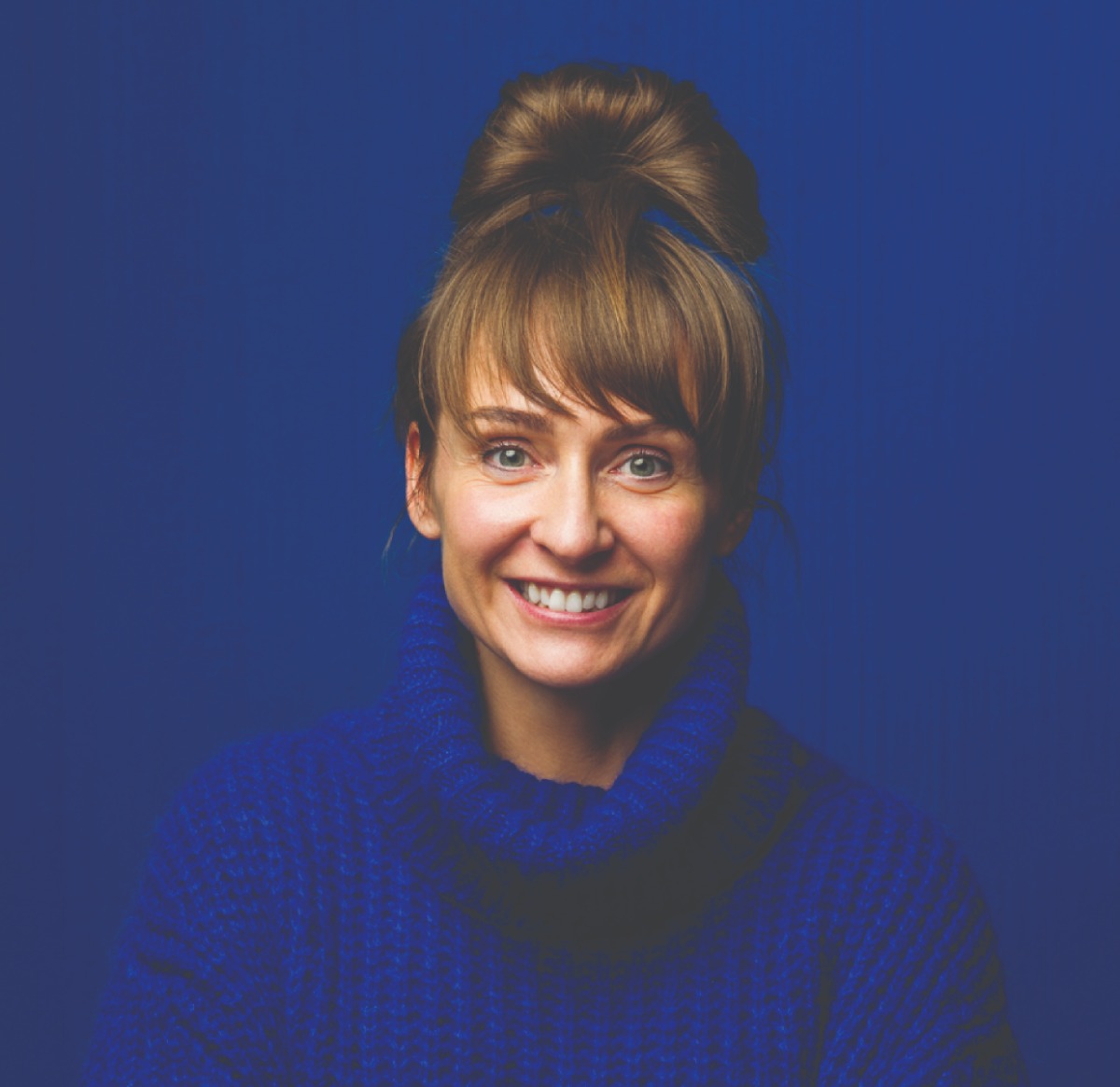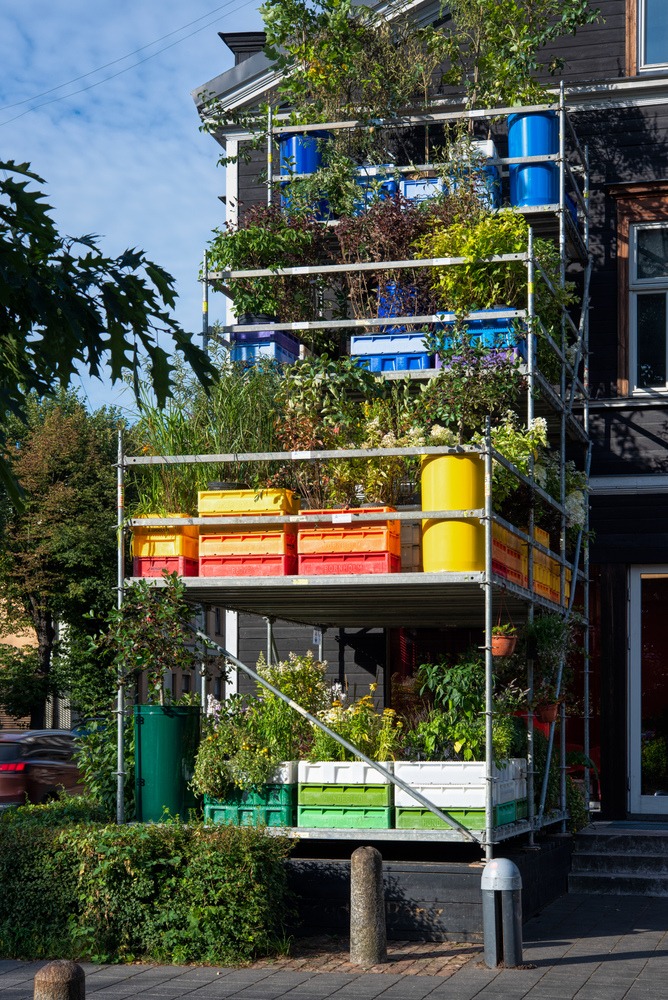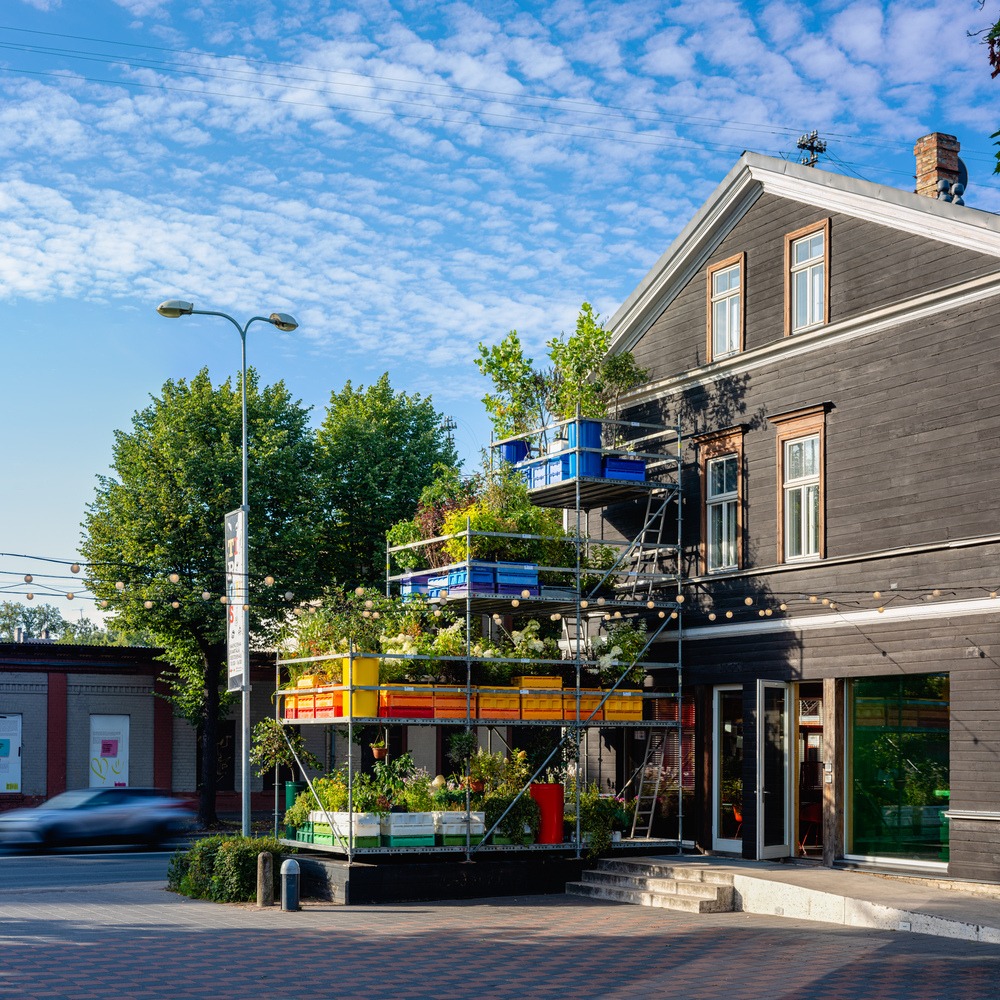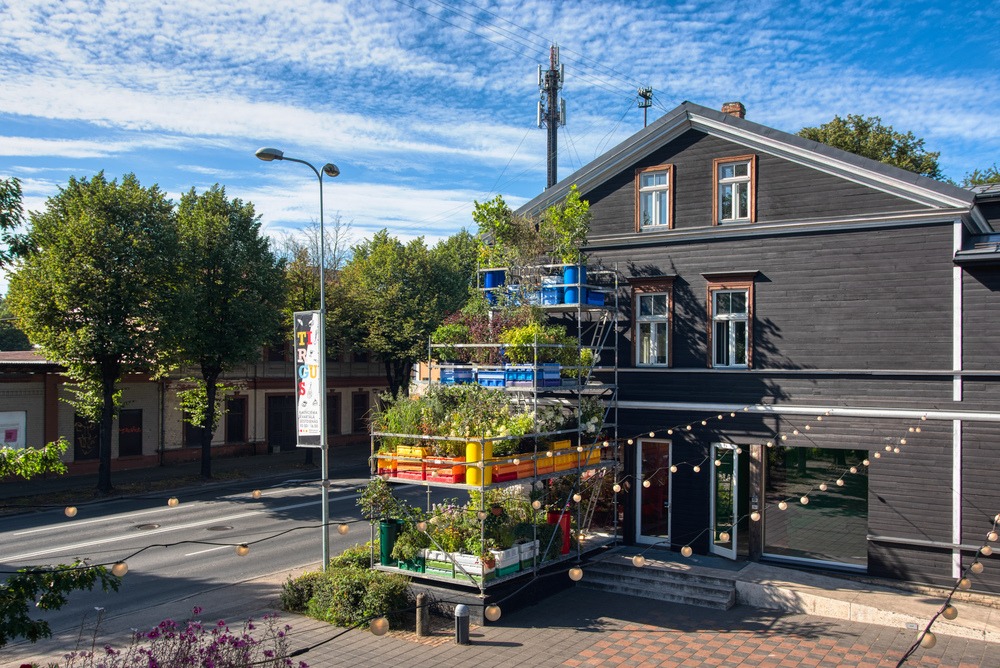
The garden as a platform for discussion
An interview with interior architect Anna Bates (formerly Butele) about the (S)AUDZĒ urban garden project
The first vertical urban garden in Riga was unveiled in late August at Kalnciema Quarter (Kalnciema kvartāls). The idea behind the project, called (S)AUDZĒ – a combination of the Latvian words for ‘to take care for’ and ‘grow/cultivate’ and translated to G(U)ARDEN in English – was developed by the Annvil design and architecture office. The garden features many local cultivars, and the project aims to become an interdisciplinary discussion space, thus educating and raising the interest of local residents in a sustainable and effective urban environment. (S)AUDZĒ serves as a demo and first phase of a series of urban gardens planned for next year in Latvia’s largest cities. Arterritory invited Anna Bates, the founder of Annvil, to a conversation.
The urban garden idea is not new, but Covid-19 has brought it to the fore, making us look at vertical gardens not only as a source of aesthetic enjoyment, a utopian vision of the green city or a work of art – as the projects of legendary French landscape architect Patrick Blanc have been viewed – but also from the functional aspect. They let us see that even die-hard city dwellers can grow tomatoes on a balcony. But they also make us wonder about the effect that the urban environment has on plants.
In our case, yes, it’s a Covid-inspired initiative. Suddenly, the concept of time became very relative for all of us, giving us many more opportunities to think things over and immense ourselves in various situations. Yes, this idea is not new, but in this particular situation I wouldn’t even call it an idea – instead, our goal is to stimulate a conversation about the future of the urban environment and the relationship between people and nature. This project is not so much about the garden itself or design or aesthetics; instead, it’s more like a functional instrument for further and deeper conversations. It’s a social initiative that turns our attention to degraded environments and green environments in urban areas. And it has involved people of all ages and from all walks of life in the discussion – the widest possible spectrum of urban dwellers.
Nowadays, much of our daily life takes place in the digital world, where everything seems reachable in mere hundredths of a second. But when we grow tomatoes, for example, we can watch them closely every day and they’re still not ripe... That might seem like an obvious observation, but I think it’s worth reminding people about this, especially children. Educating children is also one of the main goals of this project. Establishing an empathetic relationship with nature and making that a normal, daily routine – for all of society, not just children. If we start talking about it now, then in twenty years or so this idea will have become a part of our thinking and seem self-evident, even though at the moment it might seem utopian.

We’ve already received lots of feedback, both supportive and critical. The critics mostly doubt our initiative from the perspective of the quality of the food that the garden will produce. But that leads to a conversation, too. We’re collaborating with the Latvia University of Life Sciences and Technologies, and in this context a very interesting fact has been illuminated: there have as yet been quite insufficient studies regarding the impact of the urban environment on various plants. Therefore, we hope to test the plants currently growing in our pilot project at Kalnciema Quarter to see the impact of heavy metals in the environment on them. This means that by next year, when we plan to continue this series of urban gardens in other cities throughout Latvia, we will already have a much better understanding of which plants we can and cannot grow in the urban environment. Because some plants absorb heavy metals, and some are harmed by them.
One of the reasons for developing this idea of vertical gardens is that next year we’ll grow the same plants but at a higher level, and thus we’ll learn at which level the heavy metals no longer affect them. In any case, the goal of this project has never been to announce “see how we’re growing and eating these plants...”

Compared to other big cities around the world, Riga is relatively green. Nor has our link to nature been ruptured. In fact, it’s still quite strong, as confirmed by the flow of Riga residents out of the city and to rural properties at the height of the first wave of the pandemic. Do you think it will really take twenty years for this idea to become self-evident in terms of urban planning as well?
I agree that, compared to other cities (and Riga isn’t really that big), we have not lost this link to nature. But the question is whether we’ll hold on to this link in the long term if we don’t talk about it. A large increase in the global population is predicted over the next twenty years. We can, of course, be happy that we have a lot of space here and that we’re green, but any change of this magnitude affects everyone. Consequently, it’s not just about Latvia; it’s about the interests of the entire planet and the global context in general.
Many countries already have regulations in place. If I’m not mistaken, New York has a total of thirty-three hectares of roofs planted with crop-bearing plants. In Denmark, all roofs of a certain pitch or lower are planted with different types of vegetation within two years of their construction. In France, green thinking is now part of public policy, although the country already has many fields and rural areas.
But it only seems to us that everyone knows these things. I think there’s a very large part of society for whom green thinking is not self-evident. And the biggest challenge is for green thinking to become self-evident for children who are just beginning their lives. That’s exactly why we need to talk about all of this.

Nowadays there’s more and more talk about plants having a type of consciousness, a plant intentionality. Does your project address this aspect as well?
I just recently read that we need plants, but plants do not need us. And that’s why things could turn upside down very quickly and very easily.
We’ve talked about this topic a lot with researchers from the University of Latvia, and not just from the biochemical aspect of plants absorbing heavy metals. We’ve also talked about how stress affects plants.
Our goal with this project is to bring together specialists from a wide variety of fields and thus develop the project in a completely different direction. The Latvia University of Life Sciences and Technologies has offered to involve students in the project to grow seedlings from scratch, from seeds, and be present throughout the rest of the stages of plant development. Next year, we intend to implement this project not only in Riga but also in five or six more of Latvia’s largest cities. We wanted to do it already this year, and the municipalities responded positively, but they needed more time to implement the plan. So, seeing as this was a spontaneous Covid-19 initiative, we found other partners and implemented the pilot project in just a week.

How do you see Riga’s vision for future development in the context of green thinking?
A discussion is definitely needed. Right now, a lot is being talked about at the national level regarding urban planning, urban expansion and the fact that, in the global context, cities actually occupy only three percent of the land but are at the same time overcrowded. The experiment this summer on Tērbatas Street in Riga [the street was turned into a pedestrian zone for one month. – Ed.] was a great pleasure – the idea had been talked about for twenty years, and finally something happened. Finally we got to the point that the first test project in the urban context was implemented. And people really used it, thus proving the need for it. It’s great that young urban planners are trying to bring to fruition these long-discussed ideas.

Maybe your urban garden should have been implemented in Riga’s Old Town instead of Kalnciema Quarter, where it feels very organic among the existing green courtyards and wooden architecture. Maybe it would have been a much more radical statement to situate it in an area that has become kind of a dead zone to Rigans themselves?
If we look back into the past, say, those same twenty years ago – at that time Riga’s Old Town was not at all a tourist zone. It was a completely local place. The moment tourists entered the city – and don’t get me wrong, because we want tourists and need them very much – but at that moment we, the city’s residents, began to retreat. The whole Quiet Centre of the city began to develop, which, on the one hand, is sad because of how empty the Old Town is now. But on the other hand, the fact that the city centre is expanding and that socialising is increasingly taking place outside the city centre is quite laudable.
It’s an interesting mission: how to make people return to and again start using parts of the city that have been forgotten or are no longer part of their daily routines.
By the way, we initially did consider doing the project in the Old Town. We had even found a spot on Miesnieku Street where we could set up the urban garden. But it wasn’t possible to realise the project at that location as quickly as we wanted to.

We all need to start with ourselves. How has your own personal attitude towards nature and your ecological footprint changed since March?
In terms of ecological footprint, everything in my reality has changed. It might sound a bit strange, but I’m thankful for this recent experience, because in my case it meant coming to a true and complete stop. And by spending a longer period of time in one place, I’ve had the opportunity to reevaluate lots of things. My lifestyle up until the pandemic differed completely from my lifestyle now. In the five years before the pandemic, I never spent more than a week at a time in one city. My life was suitcases and constant travel – due to my work, I lived in several countries at the same time.
But I’ve now understood that I have absolutely no interest in returning to that whirlwind of a life I lived before. Of course, at the moment when everything stops, it all seems so strange, because you’re used to constantly being in motion, reaching and accomplishing everything in a hundredth of a second, even though that’s very tiring and unhealthy. But when you stop, well, that moment in itself takes quite a bit of time – time to just realise “I’m standing here...” And that’s also probably when this transformation takes place. Obviously, if you’ve always lived and worked at a savage speed, if you’ve only ever existed in intense motion, at some point you collapse.
Of course, in terms of the future of the planet, all of these initiatives of ours are actually very small. On a global scale, they might even seem laughable. But these are stories about each one of us individually...and ultimately, about all of us together. You won’t save the planet by just driving a Tesla or an electric car. We’ve destroyed so much in the past few decades that it would take us another hundred or two hundred years just to return the planet to the condition it was in a hundred or two hundred years ago. In the sense of unified thinking.
Of course, it might seem utopian considering the political and economic interests involved, but I believe that sooner or later, at some point, any movement reaches critical mass. Oscar Wilde once said that progress is the realisation of utopias. Clearly, there are still millions of absurd things going on today, but we can also look at it from a different angle – there are just as many people trying to think, develop, speak and physically do good, to effect positive change. What I mean to say is: we can’t know the precise timeline, but the process has undeniably begun.
And if we take a look at our collective understanding or thought process – where are we right now as a nation? What do we support? Where are we headed? We as individuals, as a community, and also we as a nation, a country?
In general, Riga and Latvia aren’t at a very critical point yet. But that’s why it’s important to preserve this present condition and to develop it further. But of course, the fact that we’re relatively green right now – is that the result of a conscious process, or is it a coincidence? And is it a coincidence that was influenced by an economic situation or by something else?

To what extent do you take the ecological footprint into account with your other projects? Especially considering that architecture as a field is a fairly big contributor to pollution.
In the current global economic model, it’s very difficult to unequivocally say that this is the direction we’re working in. It’s still not a global practice. Except for a few individual countries, of course. One of those is Norway, where ecological thinking is already a nationally defined policy. There isn’t even any other option there. Very soon, 70% of the cars registered in Norway will be electric cars. From this point of view, vertical gardens and the issue of pollution are no longer a topic of discussion there. Norway is the greenest country in the world. That’s all still in the future for Latvia.
In our projects, ecological footprint is still only a matter of personal initiative. In terms of customer and contractor, it’s likely to result in higher costs in the short term but will pay off in the future.
In essence, then, the urban garden project could be one of the instruments used to begin a discussion at the national level?
It’s definitely one of the ways to talk about these things and stimulate the discussion. But it’s not the solution.